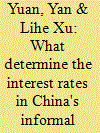|
|
|
Sort Order |
|
|
|
Items / Page
|
|
|
|
|
|
|
| Srl | Item |
| 1 |
ID:
187838


|
|
|
|
|
| Summary/Abstract |
SMEs (small and micro enterprises) in developing countries are in general financially depressed; business owners thus resort to other financial instruments (here, personal credit cards) when access to bank loans is prohibited. By investigating two different types of SMEs (namely, informal businesses and formal SMEs) in China, we find that SMEs turn to credit card debt as a substitute when they fail to obtain bank loans. Specifically, we find that households with informal businesses are more likely to use credit cards when their businesses are financially constrained. We also find that when financially constrained, formal SMEs are more likely to carry credit card debt and are also carrying more. This relationship persists after selection issues are addressed. However, credit card debt and bank loans are hardly perfect substitutes as these two instruments may function differently. Consistently, we find that even with bank loans, formal SMEs still carry substantial credit card debt. Additionally, compared to those with no fund need and thus no bank loan, formal SMEs with bank loans are carrying more credit card debt.
|
|
|
|
|
|
|
|
|
|
|
|
|
|
|
|
| 2 |
ID:
161836


|
|
|
|
|
| Summary/Abstract |
This paper first builds a simple theoretic model to explore how a special feature of enrollment policy of public primary schools in urban China, the unequal enrollment right between home owners and tenants, would produce rent-yields gap between different housings. The model also predicts that an enrollment policy featuring with tenant discrimination, accompanying with strict credit constraint, would reduce the chance of kids from middle-income families to attend better public schools while allow families with high initial wealth to access better high-quality public education at a lower cost. Using a hedonic pricing model, we find that, in Shanghai, rental yields of housings in neighborhoods associated with reputed public primary schools is on average 0.1–0.35 percentage-point lower than those associated with ordinary ones. We also explore how the rent-yields-gap varies across housing types, locations and changes over time. Nonetheless, our simulation computation suggests that the estimated opportunity cost of holding such schools in Shanghai is generally not a big amount and affordable for many families. Overall, the high entry costs of owing a housing is the major obstacle to access high-quality public primary education in urban China. These findings highlight how an education policy with features of inequality may contribute to education and residential segregation, and then reduce intergenerational mobility.
|
|
|
|
|
|
|
|
|
|
|
|
|
|
|
|
| 3 |
ID:
121804


|
|
|
|
|
| Publication |
2013.
|
| Summary/Abstract |
The interest rate is one of the most important factors in farmers' decision-making of borrowing and lending in the informal financial market in China. This paper explores the determinants of the interest rate with microfinance data. Results show that the income disparity, the relationship between borrowers and lenders, the usage of borrowing, and formal credit constraints are important factors affecting interest rates. More importantly, to borrow from those in the higher income hierarchy, farmers have to bear higher interest rates. We attribute this to different social capitals across income groups and higher default risks for the poor. This paper contributes to a better understanding of the informal financial market in rural China and sheds light on the mechanism of higher informal interest rate formation.
|
|
|
|
|
|
|
|
|
|
|
|
|
|
|
|
|
|
|
|
|